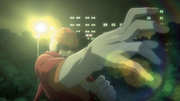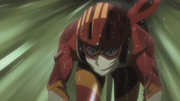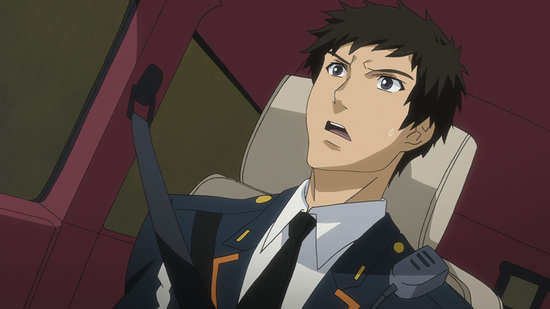Review for Samurai Flamenco - Part 1 of 2
Introduction
Pardon my French, but WTF! That’s my primary recollection of Samurai Flamenco when I watched it streamed. It is the textbook definition of a marmite show. You will either love it with a passion, or hate it to its very core, and it is indeed quite likely that you will do both over its run if you haven’t seen it before. It’s a show which sets up its premise, that will suddenly left-turn into a whole new paradigm and then it will do it again, and again, and again. Just when you are getting used to its characters and its story, it will pull the rug out from under you, requiring you to engage with it again. I went through so many cycles of ‘this is good, no, this is brilliant, WTF! why’d you do that? this is crap, no... It’s actually good, no, this is brilliant, WTF..!” that by the end of its run, I had no idea of what I had just watched, and no real idea of whether I liked it or not. So now that it’s coming out here on Blu-ray thanks to All the Anime, I get a second chance to find out what I think of the show, or at least go through the WTF rinse and repeat cycle again.
It’s also something of a miracle that it’s getting a home video release at all. My reaction to Samurai Flamenco wasn’t unique. At the time of writing, we in the UK are the only English speaking territory to get it on disc, and that’s down to the passion for the show at Anime Limited. Even then, they’re relying on their sister company @Anime in France to share the burden of disc production, as the show found enough traction with the French audience to warrant a French dub. On the other hand, Madman streamed it in Australia, and Aniplex licensed it for streaming in the US, but neither distributor has announced a home video release. On top of all that, the magnificent Manglobe, who produced Samurai Flamenco in Japan, and who have been responsible for some of my favourite anime such as Ergo Proxy, Samurai Champloo, House of Five Leaves, Deadman Wonderland, Hayate the Combat Butler, and Michiko and Hatchin, went out of business this year, which could have resulted in the sort of production committee mayhem that might have derailed a licensing agreement at the last hurdle. Fortunately All the Anime are on top of things, and so we get Part 1 of Samurai Flamenco is a sturdy collector’s edition.
Hazama Masayoshi is a male model, working his way up the popularity rankings in the hope of obtaining more fame and fortune, spurred on by his agent Ishihara. That’s his day job. What he really wants to be is a Champion of Justice, a superhero. Inspired by the TV shows he watched as a child, and his grandfather, by night he dons the suit of Samurai Flamenco, and sets forth to put right all that has gone wrong with the world. You don’t get to be a world famous superhero overnight; you have to work your way up, which is why a costumed idiot is running around the city, lecturing people about misdemeanours, and getting beaten up by middle school students. You’d think that the police would be quick to lock up such a crackpot, but fortunately for Masayoshi, the first policeman he encounters is the off-duty Goto Hidenori, who finds Masayoshi cowering naked in an alley. He’s a hard-working policeman who has up till now turned a blind eye to misdemeanours, and who maintains a long distance, text and e-mail relationship with his girlfriend. That leaves just enough romance in his heart to give Masayoshi a break, and the two even become friends, bonding over old superhero TV shows, and with Goto reining in Masayoshi’s excesses. But then Samurai Flamenco’s deeds get noticed, and things really begin to change.
Eleven episodes of Samurai Flamenco are presented across two discs from All the Anime.
1. Debut of Samurai Flamenco!
2. My Umbrella is Missing
3. Flamenco vs. Fake Flamenco
4. Idol Devastation
5. The Meaning of Justice
Disc 2
6. Capture Samumenco!
7. Change the World
8. Attack of the Army of Evil
9. Predetermined Quota
10. Final Battle at the Enemy Base
11. From Beyond
Picture
Samurai Flamenco gets a pretty generous episode distribution across two dual layer Blu-rays, so finding nits to pick about the HD transfer is tougher than usual. It’s a gorgeous transfer, clear and sharp, bringing out the vibrant palette of the show with impact and vitality. I also failed to spot any digital banding, even during the darker scenes. Given the sheer complexity of the bouncing ball end theme, a scene that will probably make a DVD transfer give up and weep, this is probably a show best served by Blu-ray. The character designs are generic anime style, but memorable enough, while the animation is fluid and doesn’t lack for energy. The action sequences are surprisingly subdued for a ‘superhero’ anime, but the real big stuff is saved for the second half of the series.
The images in this review have been kindly supplied by the distributor.
Sound
You have the option of DTS-HD MA 2.0 Stereo French, with a signs track, or DTS-HD MA 2.0 Stereo Japanese with French or English subtitles, with all options locked during playback. The Japanese audio is fine, with no dropouts, the action represented well, and the music driving the tone of the show. There’s a very Henry Mancini-esque piece in the background music that certainly stands out. The dialogue is clear, and the subtitles timed accurately, with the actors suited to their characters. One problem is that the songs aren’t subtitled, not the theme songs, and more importantly not all of the insert songs, which given that three of the characters are a girl idol group is a significant omission. Another problem is that this is one of those discs that have issues displaying subtitles and signs simultaneously. It doesn’t happen too often, but there was one flashing caption in episode 5 and one in episode 9 that I recall.
Extras
This time around I got to look at the retail product, and it’s certainly a sturdy and attractive package. You get a chipboard artbox with the two main characters either side. The BBFC certificate is a sticker on the cellophane wrap, while the blurb sheet is merely glued on the back and can be easily removed. Inside the case, you’ll find a fold-out digipack which holds the two discs on either face, and which offers more innovatively designed character artwork. Finally there is the 20-page artbook, which is full of character art.
Both discs present their content with animated menus, the credits page is where you’ll find the Japanese cast and crew translated, as well as a listing of the French dub cast. The only extras on Disc 1 amount to the textless credit sequences.
Conclusion
I think your appreciation of Samurai Flamenco will boil down to what you want your anime to be. I may be a stick in the mud/getting old (delete as appropriate), but I do want some consistency in an anime story. I can handle one, or maybe two paradigm shifts in a show, the sudden adoption of a new premise, but the show has to sell me on it when it does it, not leave me hanging for a potential explanation at the end, if one is forthcoming at all. Samurai Flamenco to me seems like an anime that wants to be everything to all viewers, and it’s chopping and changing its premise, shifting its paradigm every few episodes, and I have to admit that I just can’t keep up.
It doesn’t help that it is wholly derivative. I found it hard to watch without being reminded of other shows and movies that I have seen. On top of that, the production values really aren’t on screen. This may be a fine Blu-ray presentation, and there’s certainly plenty of detail to be had, but in terms of the actual character animation, the action sequences, Samurai Flamenco is a show that does what it needs to, and little more. Where the show needs flamboyance, flourish, and style, it offers workmanlike sufficiency. It feels like a long-running shonen anime, rather than a 22-episode, special event.
Having said that, Samurai Flamenco hooked me for a whole seven episodes this time around, as that initial, breathtaking expansion of its universe seemed a lot more natural and progressive the second time, whereas originally it felt like it was just throwing in characters randomly to change things up. I might have had the wrong idea when I first saw Samurai Flamenco, coming off the back of Tiger & Bunny, and looking for another superhero anime fix. This was less about superheroes than it was a deconstruction of the superhero genre, Unbreakable crossed with Mystery Men, and with just a touch of Batman Begins.
It’s that last scene of Batman Begins that springs to mind, that a masked vigilante begets a masked criminal, about self-fulfilling prophecies and the momentum of public opinion. Hazama Masayoshi could just be an idiot in cape; a boy who grew up immersed in superhero comics, cartoons and movies, and who decides that he will be one too. It doesn’t faze him that he lives in the ‘real world’ where such things are fiction only. As you might expect, his initial forays into (petty) crime fighting are met with predictable results. Middle school delinquents beat him up, and he’s more a nuisance to the community than a boon. But his earnest nature and do-gooding gets caught on camera, and pretty soon Samurai Flamenco is going viral.
Quite frankly, if the show had stuck to this premise, the would-be hero, and his long-suffering cop friend Hidenori Goto, I would have loved the show. It would have been a great comedy. But from episode 3, Samurai Flamenco starts adding to its universe, growing organically from its premise, it must be said. This time around, I actually appreciated its story-telling and its characters. Once you create a ‘superhero’ the world adapts to accept it. First, Masayoshi has to face another Samurai Flamenco, who turns out to be a vintage superhero TV show actor, looking to cash in on Flamenco’s sudden notoriety. Rather than clash physically, it becomes a clash of ideologies, and Masayoshi’s kung-fu turns out to be truer than Kaname Joji’s. Unexpectedly though, Joji becomes Masayoshi’s mentor.
He’s not the only one trying to get in on the superhero act though, as early on we meet MMM, an idol group whose TV show Masayoshi has a guest appearance on. It turns out that the lead singer Mari is just as much a superhero fan as Masayoshi, and pretty soon she’s donning the leotard, hiding behind a mask, all to kick evil in the nuts, although her idea of justice is markedly different from Masayoshi’s. Later on the rest of the band joins her in a superhero team. The public reaction to masked heroes is understandable. The press wants to unmask them, and when the mega-yen reward is offered, Masayoshi finds that he has to run from the very people he wants to protect. Luckily he has the secret weapons of a master stationer at his command (stapler nunchucks).
This second time around, I loved this entire opening arc, whereas during streaming I thought it was overegging the pudding. It’s a great deconstruction of the superhero genre, through the eyes of a superhero fan who takes it too seriously, and a public well versed in the genre and tropes. It’s funny, it’s interesting, and it’s thought-provoking, making the viewer re-evaluate all those superhero movies that fill the multiplexes year in and year out. But the key thing is that it is set in the real world. These superheroes have no superpowers, just some gadgetry, the costumes, and some serious delusions.
And then the guillotine gorilla shows up! From the real world to the unreal, as suddenly superpowers are real, although it’s only the villains turning into mutants and wreaking havoc through the city. Under Kaname Joji’s tutelage, Masayoshi has become a competent enough vigilante, and following the gorilla, he manages to deal with the rest of the minions of King Torture. But it’s as if the show doesn’t even want to stay with this premise that it starts. The whole King Torture arc is over in three episodes. One interesting aspect here is that the love-affair that the public briefly had with Samurai Flamenco is over, and he’s been reduced to “and finally” on the nightly news, while the seriousness with which the government takes the King Torture situation declines from scene to scene. What really appeals to me is the clash of philosophies between King Torture and Samurai Flamenco, very much echoing Unbreakable. But it’s unreal. You’ve set up a real world with masked vigilantes, apparently obeying the rules of physics, constrained by a lack of superpowers, and inspired by their own fan tendencies, and all of a sudden you have villains with actual superpowers?
My suspension of disbelief shatters at the start of the arc, and I just about start gluing the pieces together at the end, mostly on the strength of King Torture as a character, when the bottom falls out of Samurai Flamenco again, and it becomes a Power Rangers tribute act. Samurai Flamenco falls off a cliff... again... at the end of this collection of episodes, and only Part 2 will tell if it has the Oscillation Overthruster to barrel on through the Eighth Dimension and come out on the Antipodes into a better world. My recollection of the second half from streaming doesn’t inspire me. I just remembered what else the first seven episodes of Samurai Flamenco remind me of, Condorman, but good. Samurai Flamenco gets a solid Collector’s Edition from All the Anime, and it’s worth it for those first seven episodes alone.






















































Your Opinions and Comments
Be the first to post a comment!